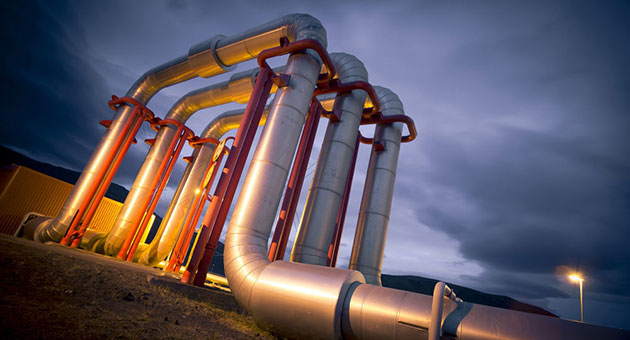The Energy Report: You and your firm have aggressively embraced the exchange-traded fund (ETF) structure. How do ETFs differ from closed-end mutual funds?
Bruno del Ama: Closed-end funds, as the name indicates, are closed, meaning they issue a fixed number of shares and they trade on an exchange. ETFs also trade on an exchange, but they are open-ended, meaning that they issue new shares or redeem shares according to investor interest in the fund. Specifically in the MLP realm, closed-end funds tend to be actively managed, whereas the MLP ETFs currently are all passive. In addition, a lot of the MLP closed-end funds use some amount of leverage, whereas the MLP ETFs do not use leverage. However, the regulatory structure for ETFs and closed-end mutual funds is very similar.
TER: Why don't ETFs trade at substantial premiums or discounts to their net asset value (NAV), the way closed-end funds can?
BdA: If there is too much demand for the closed-end fund, it will be bid up to trade at a premium to the NAV because new shares cannot be issued, but if there is not much demand, that closed-end fund could trade at a discount to the NAV. Because the ETF is open-ended, more shares are issued when there is greater demand, or redeemed when investors exit.
TER: Why do investors want access to energy MLPs?
BdA: MLPs have become an important asset class, particularly in this low-interest rate environment, where investors are seeking sources of income. MLPs tend to have lower correlation with the general market benchmarks because some of the specific structures and economics of those businesses, particularly the midstream or pipeline side of the business, operate very much like a toll road. So regardless of how the economy is doing, as long as there is natural gas or oil flowing through those pipelines, the operator and the owner of that pipeline will charge a toll. That offers a significant degree of stability.
TER: Why do you believe the ETF structure fits energy MLPs?
BdA: There are a number of vehicles to get access to MLPs. There is of course the direct investment route to individual MLPs. There are also closed-end funds, exchange-traded notes (ETNs), ETFs and the non-exchange-traded mutual funds. They all have advantages and disadvantages. For some investors, the ETF structure makes sense for a number of reasons. One is that it allows investors in tax-efficient plans such as the 401(k) or individual retirement accounts (IRAs) to invest in MLPs, which is generally not recommended when investing directly in individual MLPs through those plans. Also, the ETF structure simplifies some of the tax reporting from MLPs. With the ETF, you receive a simple 1099 like any other stock. We take care of filing all of the K-1 reports for the MLPs the ETF invests in. It is important, however, that investors access the MLP asset class cost effectively through these funds.
TER: So to summarize, there are no K-1s issued to the MLP ETF shareholder. Second, the MLP ETF can be used in qualified plans and third, I'm assuming from what you just said that there is no unrelated business taxable income (UBTI).
BdA: Correct. MLP direct investment is generally not recommended for qualified, tax-efficient plans because investors may need to pay taxes on UBTI. However, investors can buy an MLP ETF within a qualified plan and not be subject to UBTI.
TER: Why should energy investors be exposed to the small-cap MLP space?
BdA: First, the yield of junior MLP companies is around 8% versus around 6% for large-cap MLP companies. Second, there has been much less investor focus on this small-cap or junior MLP space. All of the MLP ETFs and ETNs that exist target the same large-cap space, which has received a lot of interest and fund flows. As a result, the valuations and the price-earning multiples for the junior MLPs are significantly lower than for the large-cap MLPs. Thus, this is perhaps an opportunity from a value perspective. Because values are lower, the yields paid by the junior MLP ETFs are higher.
Lastly, beyond the valuation and the higher dividend yields, there's the growth perspective in the junior MLP space, where you get more exposure to exploration and production (E&P) companies, whereas the large-cap MLPs are more focused on the infrastructure or midstream space.
TER: Bruno, isn't it hard to achieve growth in an index containing 25–30 different names? Isn't that overdiversification?
BdA: We think it's the right level. When it comes to growth and specifically the junior MLP space, small-cap companies are generally more volatile, so that diversification helps with that volatility, avoiding too much exposure to any individual name. So you have a well-balanced, well-diversified portfolio, not only at the individual company level but also within the subsectors of the MLP space.
TER: From your perspective, what is attractive about the Solactive Junior MLP Index versus other junior MLP indices?
BdA: Solactive is one of the leading firms when it comes to structuring indices for the commodity and energy space. It developed the first and only index that tracked what we consider to be a very attractive segment of the junior MLP space, the Solactive Junior MLP Composite Index.
TER: It's rare to be first in anything. Where is the growth in E&P and the midstream coming from?
BdA: There is no question that we are witnessing a massive transformation in the energy space. This has been recognized by the media, but the attention it's gotten doesn't fully represent the extent of what is taking place. According to a 2012 report from the International Energy Association, the U.S. will be the largest producer of oil in the world by 2017, and we are a massive producer of natural gas, which makes U.S. natural gas much cheaper than other areas of the world. In Asia and Europe, the same unit of gas is selling for roughly triple the U.S. price. So there is a tremendous opportunity where you have massive differences in price, not only relative to places as far as Asia but even looking at different parts of the U.S., so we are just at the beginning of building the required energy infrastructure, which will benefit MLPs tremendously. Exploration and production MLPs will be one of the biggest growth segments of MLPs, in our opinion, and these are barely represented in existing MLP funds. The Junior MLP ETF is well balanced with about 40% exposure to infrastructure MLPs and 40% exposure to exploration and production MLPs.
TER: Don't these infrastructure assets require much greater capital and resources than most small-cap companies can fund or afford?
BdA: The fact is that everybody across the value chain, from the very large players to the small players, will benefit. Building pipelines and infrastructure for energy transportation within the U.S. is really contributing to a manufacturing renaissance in the U.S. What we will see over time is consolidation with some of the larger players buying out some of the smaller ones, and some will be bought out at premiums. When you have those massive discrepancies, you are also seeing massive arbitrage opportunities and massive investments in infrastructure across the board.
TER: Bruno, could you talk about some of the companies in the Global X Junior MLP ETF (MLPJ:NYSEArca) portfolio?
BdA:Atlas Pipeline Partners L.P. (APL:NYSE) is an example of a company focused on processing and pipelines. Atlas is active in Oklahoma and Texas and operates 18 gas treatment facilities and over 10,000 miles of active pipeline. Atlas is also expected to benefit from the recent acquisition of Cardinal Midstream in December, which helped boost its pipeline assets. Atlas has a 12-month yield of 6.92%.
Atlas Resource Partners (ARP:NYSE) and BreitBurn Energy Partners L.P. (BBEP:NASDAQ) are examples of companies that are much more active on the exploration and production side. Atlas Resource Partners owns an interest in over 8,000 natural gas and oil-producing wells, which means the company will be more linked to the prices of the commodities themselves, but will also be poised to benefit from the energy renaissance taking place as the U.S. becomes a significant producer and potentially a net exporter in the future. BreitBurn has a similar focus but operates a wider range of properties, with natural gas and oil interests in California, Wyoming, Texas, Michigan, Florida, Indiana and Kentucky. Both companies manage their properties with the purpose of generating cash distributions for unitholders—Atlas Resources has a 12-month yield of 6.33% and BreitBurn has a 12-month yield of 8.67%.
- Northern Tier Energy LP
- Suburban Propane Partners
- TC Pipelines LP
- Natural Resource Partners LP
- Alliance Resource Partners LP
- Petrologistics LP
- PAA Natural Gas Storage LP
- Tesoro Logistics LP
- Atlas Pipeline Partners
- Eagle Rock Energy
- Teekay Offshore Partners
- Breitburn Energy Partners LP
- EQT Midstream Partners
- Crestwood Midstream Partners
- Exterran Partners LP
- Atlas Resource Partners
- QR Energy LP
- Pioneer Southwest Energy
- Global Partners LP
- Niska Gas Storage
- Dorchester Minerals LP
- Memorial Production
- Mid-Con Energy Partners
- Rhino Resource Partners LP
Bruno del Ama is the co-founder and chief executive officer of Global X Funds, a New York-based provider of exchange-traded funds that facilitates access to investment opportunities across global markets. Founded in 2008, Global X Funds has been ranked by BlackRock as the fastest-growing ETF company in the world in 2010 and received awards as the most innovative ETF provider by its peers in both North America and Europe. Before co-founding the firm, del Ama served as head of operations in the structured products business at Radian Asset Assurance. Prior to that, he was a senior consultant at Oliver Wyman advising leading financial services firms in a range of strategy matters. He earned his Master of Business Administration from the Wharton School of the University of Pennsylvania and is a CFA charter holder.
Want to read more Energy Report interviews like this? Sign up for our free e-newsletter, and you'll learn when new articles have been published. To see a list of recent interviews with industry analysts and commentators, visit our Exclusive Interviews page.
DISCLOSURE:
1) George S. Mack of The Energy Report conducted this interview. He personally and/or his family own shares of the following companies mentioned in this interview: None.
2) The following companies mentioned in the interview are sponsors of The Energy Report: None. Interviews are edited for clarity.
3) Bruno del Ama: I personally and/or my family own shares of the following companies mentioned in this interview: None. I personally and/or my family am paid by the following companies mentioned in this interview: Global X Junior MLP ETF and Global X MLP ETF. I was not paid by Streetwise Reports for participating in this interview.




























































